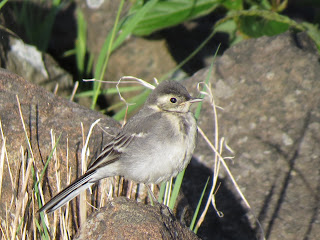8.5°C > 12.5°C: Mainly clear with a few clouds to N and some thin high cloud later. Almost calm start with light / moderate WSW wind. Very good visibility
Sunrise: 04:49 BST
Priorslee Lake: 04:00 – 05:20 // 06:15 – 07:50
(73rd visit of the year)
The amount of birdsong has diminished markedly the last few days as birds either finish breeding or are too busy raising more broods. Most bird are still singing but sporadically
Notes from today:
- early I counted 7 adult Great Crested Grebes and the usual 2 juveniles; later one adult took off, circled gaining height and left to the W; later still there were still seven adults present so presumed it was an eighth that flew off
- similar behaviour from the Swifts: first arrivals just before 04:30 rapidly built up to c.30 birds most of which soon moved on. Thereafter between 6 and 12 birds joined by a single House Martin for a while
- a complete lap pre-sunrise netted me 10 singing Song Thrushes (I usually watch flyovers from the W end to start the visit but at the moment there are none to watch!)
- juvenile Pied Wagtails on both one of the boat-launching platforms and the dam-face
and
- a Light Emerald moth on the lamps was new for me this year
- single May Highflyer, Silver-ground Carpet and White Ermine moths were all repeat visits to the lamps
- Timothy Tortrix and Common Marble moths flushed from vegetation
- my first skipper butterfly of the year –a Large Skipper
- the usual trio of Blue-tailed Damselflies, Common Blue and Azure Damselflies
- a live Red-and-Black Froghopper (Cercopis vulnerata) [previously bodies only in a web]
- 100s of the caddis fly Mystacides longicornis dancing around the edge of the water
On with the bird totals
Birds noted flying over the lake:
- 5 Greylag Geese (2 groups)
- 1 Lesser Black-backed Gull
- 2 Wood Pigeons
- 5 Starlings
- 5 Jackdaws
Hirundine etc. counts:
- >30 Swifts again
- 1 House Martin
Warblers counts: number in brackets = singing birds
- 5 (5) Chiffchaffs
- 1 (1) Willow Warbler still
- 15 (13) Blackcaps
- 2 (2) Garden Warblers
- 5 (3) Common Whitethroat
- 4 (4) Reed Warblers
The counts from the lake area
- 2 + 4 Mute Swans
- 12 (10♂) + 4 (1 brood) Mallard
- 8 + 2 (1 brood) Great Crested Grebes (see notes)
- 3 Moorhens
- 30 Coots
Not a very inspiring sunrise.
Somewhat selective: the most interesting part.
Here is the 8th Great Crested Grebe leaving.
Another view – not often I get a chance to photograph flying grebes in such good light.
One of the juvenile Pied Wagtails: has lost most of he ‘eggy’ look at the base of the bill.
A female Common Blue Damselfly: a hint of a blue cast to the body.
A Red-and-Black Froghopper (Cercopis vulnerata).
Now this is different: if I am sorting things out correctly it is a Marsh Orchid (Orchis strictifolia) ....
... as is this, in close-up (with a buttercup getting a look in).
----------------------------------------------------------------------------------------------
The Flash: 05:30 – 06:10
(54th visit of the year)
Notes from here
- my first Greylag Geese here since 08 April – nearly 2 months
- Canada Geese back in some number after yesterday’s low count: 14 of them flew in while I was present
- the Tufted Duck were very noisy and flew around several times; also climbed out and scampered around on the island for a while
- my first Grey Herons since a fly-over also on 08 April – and then there two having a dispute
- no Great Crested Grebes located
- one of the Moorhens a very grown juvenile – obviously from an early brood
- party of Long-tailed Tits of at least 13 birds, many of them juveniles
Birds noted flying over
None
Hirundine etc. counts
- 8 Swifts
- 2 House Martins
Warblers counts: number in brackets = singing birds
- 4 (3) Chiffchaffs
- 3 (3) Blackcaps
The counts from the water
- 2 + 7 Mute Swans
- 4 Greylag Geese
- 81 Canada Geese!
- 1 white feral goose
- 15 (14♂) Mallard
- 2 (1♂) Tufted Duck still
- 2 Grey Herons
- 2 + 1 Moorhen
- 16 + 5 (2 broods) Coots
Between the lake and The Flash alongside the path
- a juvenile Moorhen scampered back into the shelter of the lower pool
- a Chiffchaff back singing alongside the lower pool
(Ed Wilson)
------------------------------------------------------------------------------------------------------


















